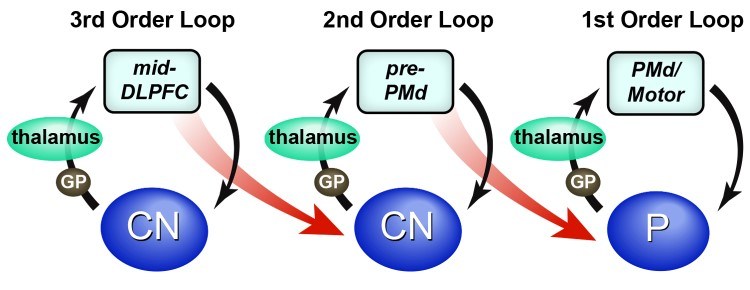Policies for working memory gating can be learned through dopamine modulation of this system in the same way that we discussed for motor gating. In other words, they learn to gate contexts that have led to positive outcomes. Computational neural network models that implement this architecture have demonstrated that it can learn the right gating policies to control itself. Moreover, these models can generalize and reuse a gating policy learned in one setting to new tasks. Hence, this mechanism can implement working memory gating policies for control without a homunculus to set them up in just the right way.
Motor Gating through Cortico-Striatal Loops

Importantly, in the human brain, these cortico-striatal-thalamic loops are elaborated beyond the motor and premotor cortex to extend into prefrontal cortex. Neurons in the prefrontal cortex code and maintain information about our abstract rules, goals, and plans. Thus, in the prefrontal cortex, gating circuits can regulate input and output of these higher order contexts. In other words, they can enact a mechanism for working memory gating. The computations of these canonical circuits are analogous to the motor loop. But, rather than considering whether a specific motor act should be gated, these feedback loops are making gating decisions about whether to maintain or amplify higher order goals and contexts. These canonical gating loops are also topographic meaning that they can regulate specific populations of cells in cortex, and so selectively gate memory.
Coming back to our homunculus problem, how does the cortico-striatal loop know which motor acts to gate out and which not to? Among its inputs, the striatum receives rich input from dopamine neurotransmitter systems. Dopamine signals can convey information about learned reward expectations and violations of those expectations. An increase in dopamine in striatum, will both increase the likelihood that an action being considered will be gated (a “Go bias”), and it also causes a change at the synapse such that reoccurrence of this combination of motor plan and context will be more likely to be gated in future. Conversely a dopamine dip makes future motor gating less likely. Thus, over time, the striatum comes to learn about when and what motor acts to gate through dopamine modulation.
Canonical Gating Circuits for Working Memory
This model may also help address a second major hurdle for theory in cognitive control: the scaling problem. Most models of cognitive control are developed to account for simple laboratory tasks, but they fail to account for how the system can scale up to the complexity of our everyday lives. One example of this is the hierarchical nature of action control, as in the coffee-making example from the last post. In the human brain, there are multiple cortico-striatal loops that are organized such that they can regulate different parts of cortex but also influence each other through nesting interactions (see Figure 1). In other words, the context (e.g., driving) being gated out of one loop can influence the action (e.g., press mute) being gated out of another. These interactions among nested cortico-striatal loops offer one account for control of more complex, hierarchical action.
The homunculus problem is a recurring challenge for theories of cognitive control. Specifically, we want a theoretical account of how we link goals with actions that doesn’t require the system to somehow just know how it’s done, i.e., based on the just-so decisions of a little person in the head. The mechanism of working memory gating I have sketched so far suffers from this theoretical shortcut. For example, how does the system know that driving a car is the right context to input gate or that a phone buzzing is the right moment to output gate? To understand how this might happen in the brain, I will first outline one plausible systems-level neural mechanism for working memory gating through cortico-striatal-thalamic loops.
In the last two posts, we have seen how working memory gating may be an important mechanism for cognitive control and may be implemented through cortico-striatal loops in the brain. This is an example of one control mechanism. It is important to emphasize, however, that cognitive control is not one faculty or mechanism but rather emerges from several interacting systems for internally guiding action. With this in mind, tomorrow, we will consider another facet of control in a discussion of inhibition.
Before we make a movement, neurons in the premotor cortex fire in a pattern that represents our motor plan. Initially, this firing is too weak to elicit firing in motor cortex that leads to a movement. This is because the firing dynamics between thalamus and premotor cortex are inhibited by a set of subcortical structures in the basal ganglia. Eliciting a movement requires this inhibition to be removed, i.e., disinhibited, by influence from another structure in the basal ganglia called the striatum (see Figure 1). The striatum will engage this disinhibitory dynamic – or it won’t – based on input it receives from premotor cortex about the proposed movement and input about the broader context it receives from elsewhere in cortex. In this way, the striatum forms, with the premotor cortex, a feedback loop regarding the motor plan being proposed. In particular, it will amplify actions that are useful to take in the present context. In effect, this is a motor gate. It allows us to consider actions without doing them, which is an adaptive and highly conserved function of this circuit.
